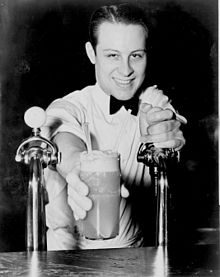Ice cream float
 |
|
| Alternative names | Ice cream float, Coke float, root beer float, spider |
|---|---|
| Type | Beverage |
| Place of origin | United States |
| Created by | Robert McCay Green |
| Main ingredients | Ice cream; soft drink, or syrup and carbonated water |
| |
|
An ice cream float or soda (United States, United Kingdom, Canada, South Africa and East Asia), coke float (United Kingdom), root beer float (United States, Canada) or spider (Australia and New Zealand), is a beverage that consists of ice cream in either a soft drink or in a mixture of flavored syrup and carbonated water.
The ice cream float was invented by Robert McCay Green in Philadelphia, PA, in 1874 during the Franklin Institute's semicentennial celebration. The traditional story is that, on a particularly hot day, Mr. Green ran out of cold ice for the flavored drinks he was selling and used vanilla ice cream from a neighboring vendor, thus inventing a new drink.
His own account, published in Soda Fountain magazine in 1910, states that while operating a soda fountain at the Franklin Institute's semicentennial celebration in Philadelphia in 1874, he wanted to create a new treat to attract customers away from another vendor who had a fancier, bigger soda fountain. After some experimenting, he decided to combine ice cream and soda water. During the celebration, he sold vanilla ice cream with soda water and a choice of 16 different flavored syrups. The new treat was a sensation and soon other soda fountains began selling ice cream floats. Green's will instructed that "Originator of the Ice Cream Soda" was to be engraved on his tombstone.
There are at least three other claimants for the invention of ice cream float: Fred Sanders, Philip Mohr, and George Guy, one of Robert Green's own employees. Guy is said to have absent-mindedly mixed ice cream and soda in 1872, much to his customer's delight.
Regardless of its origins, the beverage quickly became very popular, to such a degree that it was almost socially obligatory among teens, although many adults did not like it. According to some accounts, it was banned, either entirely or on holy days, by some local governments, giving rise to a substitute treat, the sodaless ice cream sundae. As carbonated drinks were marketed as a miracle cure, they were often considered a substance that required oversight and control like alcohol, another controlled substance that could not be served or purchased on Sundays in many conservative areas. Many soda fountains had to figure out a way to turn a profit on Sundays when selling their product was considered illegal. The solution was to serve ice cream on these days, as it is merely a food product and not a controlled substance. Soda fountains then coined the term "Sundaes" for the ice cream concoctions that they served on "soda's day of rest".
...
Wikipedia
